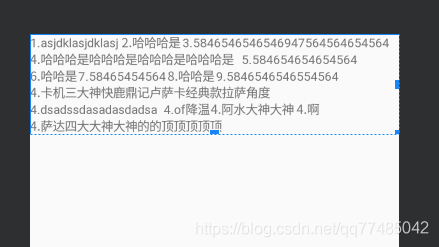
最近要使用一个这样的标签流式布局,网上很多资源,自己试着自定义了一下效果图如上。
实现逻辑分析:
1.这是一个自定义的TagLayout肯定要继承自ViewGroup。
2.要自动换行,那容器的宽和高是不固定的需要根据子View的多少的宽高来确定自己的宽高。
3.继承ViewGroup肯定是要实现它的OnLayout去摆放子View的位置。
大概逻辑就是以上三部,可以总结出来需要重写ViewGroup的onMeasure()和onLayout()方法。
先重写onMeasure()方法:
1.获取子View的数量。
2.for循环测量每个子View的宽高。
3.记录每个子View的宽度进行累加,当宽度大于一行的宽度时,高度需要加上子View的高度。
4.记录累加的宽高值设置容器的宽高。
@Override
protected void onMeasure(int widthMeasureSpec, int heightMeasureSpec) {
super.onMeasure(widthMeasureSpec, heightMeasureSpec);
//记录值,靠这个值判断是否宽度不够了
int width = 0;
myWidth = MeasureSpec.getSize(widthMeasureSpec);
myHeight = 0;
//1.获取布局中有多少个子View
int childCount = getChildCount();
int maxHeight = 0;
for (int i = 0; i < childCount; i++) {
//获取每个子View
View childView = getChildAt(i);
//2.测量每个子View
measureChild(childView, widthMeasureSpec, heightMeasureSpec);
//3.记录每个子View的宽度进行累加,当宽度大于一行的宽度时,高度需要加上子View的高度。
if (width + childView.getMeasuredWidth() > myWidth) {
myHeight += childView.getMeasuredHeight();
width = 0;
} else {
width += childView.getMeasuredWidth();
maxHeight = Math.max(childView.getMeasuredHeight(), myHeight);
}
}
myHeight += maxHeight;
//4.记录累加的宽高值设置容器的宽高。
setMeasuredDimension(myWidth, myHeight);
}
在重写onLayout()方法:
1.获取容器中的子View数量。
2.for循环控制每个子View的摆放位置。
3.摆放每个子View。
@Override
protected void onLayout(boolean changed, int l, int t, int r, int b) {
int w = 0;
int left = 0;
int top = 0;
//1.获取布局中有多少个子View
int childCount = getChildCount();
//2.for循环控制每个子View的摆放位置
for (int i = 0; i < childCount; i++) {
View childView = getChildAt(i);
int MeasuredWidth = childView.getMeasuredWidth();
int MeasuredHeight = childView.getMeasuredHeight();
if (w + MeasuredWidth > myWidth) {//需要换行
left = 0;
top += MeasuredHeight;
w = 0;
}
//3.摆放每个子View
childView.layout(left, top, left + MeasuredWidth, top + MeasuredHeight);
left += MeasuredWidth;
w += MeasuredWidth;
}
}
关键逻辑都在这两个方法中。
以下就是全部代码:
package com.zg.viewdemo;
import android.content.Context;
import android.util.AttributeSet;
import android.view.View;
import android.view.ViewGroup;
public class TagLayout extends ViewGroup {
int myWidth;
int myHeight;
public TagLayout(Context context, AttributeSet attrs) {
super(context, attrs);
}
@Override
protected void onMeasure(int widthMeasureSpec, int heightMeasureSpec) {
super.onMeasure(widthMeasureSpec, heightMeasureSpec);
//记录值,靠这个值判断是否宽度不够了
int width = 0;
myWidth = MeasureSpec.getSize(widthMeasureSpec);
myHeight = 0;
//1.获取布局中有多少个子View
int childCount = getChildCount();
int maxHeight = 0;
for (int i = 0; i < childCount; i++) {
//获取每个子View
View childView = getChildAt(i);
//2.测量每个子View
measureChild(childView, widthMeasureSpec, heightMeasureSpec);
//3.记录每个子View的宽度进行累加,当宽度大于一行的宽度时,高度需要加上子View的高度。
if (width + childView.getMeasuredWidth() > myWidth) {
myHeight += childView.getMeasuredHeight();
width = 0;
} else {
width += childView.getMeasuredWidth();
maxHeight = Math.max(childView.getMeasuredHeight(), myHeight);
}
}
myHeight += maxHeight;
//4.记录累加的宽高值设置容器的宽高。
setMeasuredDimension(myWidth, myHeight);
}
@Override
protected void onLayout(boolean changed, int l, int t, int r, int b) {
int w = 0;
int left = 0;
int top = 0;
//1.获取布局中有多少个子View
int childCount = getChildCount();
//2.for循环控制每个子View的摆放位置
for (int i = 0; i < childCount; i++) {
View childView = getChildAt(i);
int MeasuredWidth = childView.getMeasuredWidth();
int MeasuredHeight = childView.getMeasuredHeight();
if (w + MeasuredWidth > myWidth) {//需要换行
left = 0;
top += MeasuredHeight;
w = 0;
}
//3.摆放每个子View
childView.layout(left, top, left + MeasuredWidth, top + MeasuredHeight);
left += MeasuredWidth;
w += MeasuredWidth;
}
}
}
<?xml version="1.0" encoding="utf-8"?>
<RelativeLayout xmlns:android="http://schemas.android.com/apk/res/android"
xmlns:tools="http://schemas.android.com/tools"
android:layout_width="match_parent"
android:layout_height="match_parent"
tools:context=".MainActivity">
<LinearLayout
android:layout_width="match_parent"
android:layout_height="wrap_content"
android:orientation="vertical">
<com.zg.viewdemo.TagLayout
android:layout_width="match_parent"
android:layout_height="wrap_content">
<TextView
android:layout_width="wrap_content"
android:layout_height="wrap_content"
android:text="1.asjdklasjdklasj" />
<TextView
android:layout_width="wrap_content"
android:layout_height="wrap_content"
android:text="2.哈哈哈是" />
<TextView
android:layout_width="wrap_content"
android:layout_height="wrap_content"
android:text="3.5846546546546947564564654564" />
<TextView
android:layout_width="wrap_content"
android:layout_height="wrap_content"
android:text="4.哈哈哈是哈哈哈是哈哈哈是哈哈哈是" />
<TextView
android:layout_width="wrap_content"
android:layout_height="wrap_content"
android:text="5.584654654654564" />
<TextView
android:layout_width="wrap_content"
android:layout_height="wrap_content"
android:text="6.哈哈是" />
<TextView
android:layout_width="wrap_content"
android:layout_height="wrap_content"
android:text="7.58465454564" />
<TextView
android:layout_width="wrap_content"
android:layout_height="wrap_content"
android:text="8.哈哈是" />
<TextView
android:layout_width="wrap_content"
android:layout_height="wrap_content"
android:text="9.5846546546554564" />
<TextView
android:layout_width="wrap_content"
android:layout_height="wrap_content"
android:text="4.卡机三大神快鹿鼎记卢萨卡经典款拉萨角度" />
<TextView
android:layout_width="wrap_content"
android:layout_height="wrap_content"
android:text="4.dsadssdasadasdadsa" />
<TextView
android:layout_width="wrap_content"
android:layout_height="wrap_content"
android:text="4.of降温" />
<TextView
android:layout_width="wrap_content"
android:layout_height="wrap_content"
android:text="4.阿水大神大神" />
<TextView
android:layout_width="wrap_content"
android:layout_height="wrap_content"
android:text="4.啊" />
<TextView
android:layout_width="wrap_content"
android:layout_height="wrap_content"
android:text="4.萨达四大大神大神的的顶顶顶顶顶" />
</com.zg.viewdemo.TagLayout>
</LinearLayout>
</RelativeLayout>
版权声明:本文为qq77485042原创文章,遵循 CC 4.0 BY-SA 版权协议,转载请附上原文出处链接和本声明。